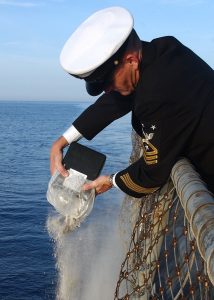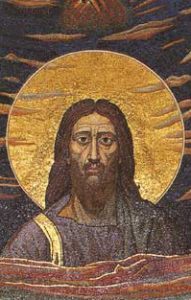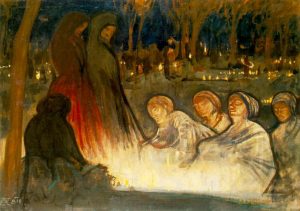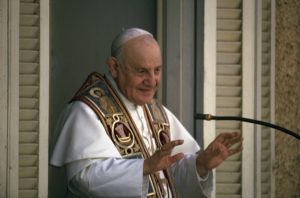The Congregation for the Doctrine of the Faith gave an instruction, Ad resurgendum cum Christo (“To Rise With Christ”) concerning the dignity of ashes/cremains of the deceased member of the Faithful.
Ad resurgendum cum Christo (2016) is a binding Roman Curial document governing the life of the church, which was explicitly approved by the Pope with his express order. Yet, this document reveals nothing new as it is a clarification with an attempt reinforce existing canonical and liturgical (ritual) norms already in force. Until 1963, the Catholic Church prohibited cremation because of the fitting nature of keeping intact the visible unity the body, its dignity (even in death) and the theology of the resurrection of the body (see Nicene Creed) the Last Day. Likewise, the Church’s teaching desired to counter philosophical views that rejected the teaching explicitly Christian belief in bodily resurrection. The permission for cremation was put into the Code of Canon Law in 1983 for the Latin Church and the Code of Canons of the Eastern Churches in 1990.
For our purposes here, Ad resurgendum cum Christo reiterates the long held view that the Church is not opposed to the practice of cremation (canons 1176.3 and 1184.1 no.2 refer to burial and cremation).
Our theology is rooted in the body. It is a theology and an anthropology based in revelation and sacramentality of Christian Initiation (baptism, confirmation and Eucharist) integrating total person –body, soul, and spirit– as the subject as the center and locus of salvation in Christ Jesus.
The most eye-grabbing part of the instruction for many is the re-iteration of the prohibition on the scattering of ashes following the Mass of Christian Burial.
Ad resurgendum cum Christo teaches:
She [the church] cannot, therefore, condone attitudes or permit rites that involve erroneous ideas about death, such as considering death as the definitive annihilation of the person, or the moment of fusion with Mother Nature or the universe, or as a stage in the cycle of regeneration, or as the definitive liberation from the “prison” of the body. (no. 3)
Hence, we can understand the author meaning by “fusion with Mother Nature or the universe” as the practices people do in disposing of the ashes of the beloved: the scattering of their ashes over particular lands, mountains, or waters. The Church reminds us that it is strictly prohibited to divide the ashes among family or their reservation in a home, although culturally sensitive exceptions allowing domestic repose of cremains are left open to the local ordinary, presuming “agreement with the Episcopal Conference or Synod of Bishops of the Oriental Churches” (no. 6). Additionally, we faithful Catholics do not accept philosophies that speaks to “pantheism, naturalism, or nihilism.” It is taught that the ashes cannot be “preserved in mementos, pieces of jewelry, or other objects” (no. 7).
You ought to read the document because I bet that many will not realize that the burial of the body or deposition of the ashes in consecrated ground is matter of doctrine. Our disposition of the ashes in a sacred place keeps departed from being forgotten or their remains from being shown a lack of respect.
“The faithful departed remain part of the Church who believes “in the communion of all the faithful of Christ, those who are pilgrims on earth, the dead who are being purified, and the blessed in heaven, all together forming one Church” AND The reservation of the ashes of the departed in a sacred place ensures that they are not excluded from the prayers and remembrance of their family or the Christian community. It prevents the faithful departed from being forgotten, or their remains from being shown a lack of respect, which eventuality is possible, most especially once the immediately subsequent generation has too passed away. Also it prevents any unfitting or superstitious practices” (no. 5).
Catholics believe in the resurrection of the flesh as fundamental point of received theology and therefore, in death, the body is not incidental unimportant and nor is it trash. Ours is a personal religion holding to the point that what we do with the body matters. No person is anonymous and the burial or disposition of ashes in a way that rejects the history of a person (the name, the person, the identity of the person) is contrary to common Catholic practice and belief. Belong to the communion of saints through grace. God created each person and calls each person to Himself at the time of death.
Anyone working in a parish these days will acknowledge the difficulties in working Catholics today in the face of culture; the “unchurched” or those labelled as “nones” are rapidly becoming a problem due to a lack of education, a desire to really know and understand the teachings of Divine Revelation and the Church. The unchurched allow socio-economic-political priorities and personal mores to trump truth. Try speaking with a grieving person (or a pre-grieving person) about the church’s scriptural, doctrinal, and sacramental/ritual reasons for requiring that the corpse or cremains be present for the wake and funeral mass and that cremains be finally placed in a cemetery or columbarium… and you will see the problems at hand and vitriol heaped on a pastoral minister. I have had to try to convince daily-Mass Catholics to bury the ashes placing Mom on the mantlepiece in their living room or a closet or giving half the ashes to a friend. Not easy.
When John F. Kennedy, Jr. died with his wife in a plane accident in 1999, the burial of cremains was at sea. The cremains went into a container and dropped overboard at sea. The family and Church made the distinction between “burial at sea” and “scattering at sea.” While many say this a distinction without a difference, but there is a difference. A burial at sea has the cremains remain intact and together. With the scattering of the cremains are scattered; i.e., no container to hold human remains together. The same would apply to burial of a body at sea. The Catholic question here is the integrity of the remains.
Archbishop Peter Sartain, paraphrasing an Easter homily of Cardinal George’s in his homily at Cardinal George’s funeral Mass said: “If the earth is our mother, then the grave is our home and the world is a closed system turned in on itself. If Christ is risen from the grave and the Church is our mother, then our destiny reaches beyond space and time, beyond what can be measured and controlled.”
We all should read St Paul’s First Letter to the Corinthians 15.







